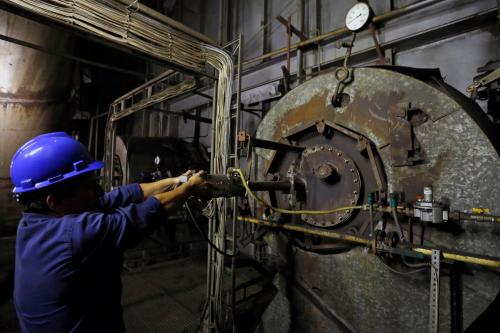As the first in a series of two, this blog explores Romania’s supply-side skills gaps and demand-side skills shortages.
Romania has experienced significant progress in recent years with its income per capita rising from about 50 percent of the European Union average in 2010 to about 70 percent currently. However, the country faces several skill challenges if it wishes to move its economy to the global economic frontier. Being at the frontier requires the right skills, as well as training models that allow individuals, firms’ employees, and countries’ workforces to update their skills frequently and efficiently to meet changing needs.
Romania is characterized by acute skills gaps and shortages that cause skills mismatches in the labor market. These skill challenges include an insufficient quantity of general education compared to peers, uneven skills distribution among tertiary graduates, relatively low foundational cognitive (literacy and numeracy) and socio-emotional skills, and shortages of high-skilled white-collar and low-skilled blue-collar workforces. They are likely to be magnified by the impact of COVID-19, as the lockdown has left thousands of workers unemployed and forced schools and universities to close, increasing the likelihood of skill depreciation.
Supply-side skills gaps
Skills gaps refer to inadequacies in the quantity, quality, and types of skills available in the workforce. Romania’s pool of potential and actual workers is relatively less educated than the rest of the EU, while there are also significant regional disparities within the country. In 2017, only 15 percent of Romania’s working-age population had completed tertiary education, while 27 percent had less than upper secondary education, both significantly worse than the EU average.
Romania has many overeducated workers in low-skilled, blue-collar occupations. However, the country’s proportion of undereducated workers in high-skilled, blue-collar occupations exceeds both its peers (Poland, Hungary, and Bulgaria) and the EU average. Conversely, a significant proportion of workers in high-skilled, white-collar and high-skilled, blue-collar jobs in suburban and rural areas don’t have the skills to perform their jobs effectively. Technicians and associate professionals, skilled agricultural workers, and all low-skilled, blue-collar workers are the occupations with the most vertical mismatches (see Figure 1), which refers to a misalignment between the level of education required for an occupation and the actual level of education of the worker in that occupation.
The skills proficiency of current or future workers, especially in rural areas, most likely compromises their ability to be productive at the workplace. Based on their low scores in PISA tests, Romanian workers aged between 19 and 28 appear to lag EU countries in foundational skills proficiency. About 50 percent of the 2006 student cohort currently in the labor market had low reading and numeracy proficiency, compared to approximately 20 percent in the EU. Romanian students are on average one-and-a-half years of schooling behind students across EU countries. Likewise, results for the national assessment in grade 8, a test of accumulated foundational skills, show an increasing share of low-performing students moving into the upper secondary level. In 2018 only 30 percent of students passed the baccalaureate examination with a score higher than 8.5 out of 10, the technological profile being the worst, with only 6.5 percent of outstanding performers. A 2017 World Bank Group study showed that an estimated 90 percent of technical and vocational (TVET) students fail to reach the level needed to get full value from studies at the tertiary level or to meet requirements in the labor market. Furthermore, employers strongly believe that current employees, students, and graduates entering the labor market lack key socio-emotional skills.
A relatively high proportion of Romanians with tertiary education in some fields are either overeducated for their occupations (Figure 2, LHS: vertical mismatching) or working in a sector that does not match their field of education (Figure 2, RHS: horizontal mismatching). As the Romania CEM2.0 Report illustrates, distortions from the labor market can magnify this mismatching, especially when there is asymmetry of information and/or socio-cultural bias in hiring and promoting practices.
Demand-side skills shortages
Skill shortages refer to situations where the demand for a certain skill exceeds the supply. Over the last five years, economic activity has been strong in Romania, with GDP growing at 4.5 percent annually. Growth has been strong in most regions, especially in Bucharest-Ilfov and the western regions, but average annual employment growth, at only 0.3 percent nationally, has been almost stagnant. This reflects a challenge that firms face in trying to fill open positions, especially in high-skilled occupations but also to an extent in low-skilled blue-collar jobs. Across all regions, vacancy rates are increasing. At a national level, the vacancy rate increased from 0.6 percent in 2012 to 1.23 percent in 2017. These vacancies are higher in high-skilled, white-collar occupations, explaining, at least in part, the relatively high proportions of undereducated workers in those occupations. Contributions to total vacancy rates of low-skilled, blue-collar occupations (elementary occupations, plant and machine operators, and assemblers) are also high in regions other than Bucharest-IIfov, resulting in very high proportions of overeducated workers in those positions. The faster growing sectors, like transportation and storage, information and communications technology (ICT), manufacturing, and even slower growing sectors like human health and social work activities, arts, entertainment, and recreation, face significant labor shortages. For instance, the ICT sector experienced a vacancy rate of 1.3 percent in 2017, while that of health and human services reached 2.8 percent. In parallel, automation of production processes has started driving up demand for higher levels of cognitive skills, while jobs involving routine application of procedural knowledge are shrinking; the COVID-19 pandemic has, with some justification, heightened fears that automation of jobs could be further accelerated.
As can be seen, given increased uncertainty and accelerated rates of change arriving in the workplace, Romania should consider new forms of skills development arrangements that can better support workers of different segments of the age profile, and more readily prepare them for re-skilling throughout their lives. In the next blog, the authors explore underlying causes of Romania’s skills deficit and propose strategies to tackle them.
The Brookings Institution is committed to quality, independence, and impact.
We are supported by a diverse array of funders. In line with our values and policies, each Brookings publication represents the sole views of its author(s).










Commentary
Romania’s long-term growth challenge: Raising the alarm of skills deficit
July 22, 2020